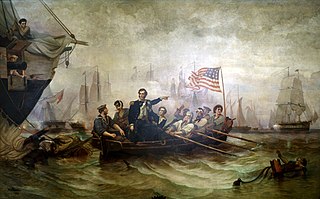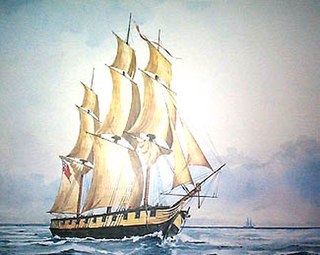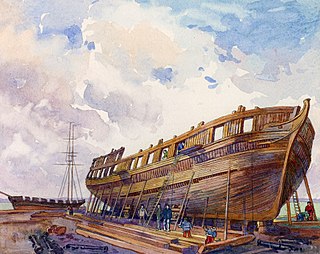
The Battle of Lake Erie, also known as the Battle of Put-in-Bay, was fought on 10 September 1813, on Lake Erie off the shore of Ohio during the War of 1812. Nine vessels of the United States Navy defeated and captured six vessels of the British Royal Navy. This ensured American control of the lake for the rest of the war, which in turn allowed the Americans to recover Detroit and win the Battle of the Thames to break the Indian confederation of Tecumseh. It was one of the largest naval battles of the War of 1812.

HMS Detroit was a 20-gun sloop of the Royal Navy, launched in July 1813 and serving on Lake Erie during the War of 1812. She was the most powerful British ship in the Lake Erie squadron until the Americans captured her during the Battle of Lake Erie on 10 September 1813. Detroit was commissioned into the United States Navy as its first USS Detroit. However, she was so damaged that the sloop took no further part in the war. Postwar, Detroit was sunk for preservation at Misery Bay off Presque Isle until 1833, when she was refloated and converted for commercial service. In 1841, Detroit was reduced to a hulk at Buffalo, New York, where she was purchased with the intent of sending her over Niagara Falls. The plan went awry and Detroit ran aground on a shoal before the falls and broke up.

Detroit was a 6-gun brig launched in 1798 as Adams in the United States. During the War of 1812 the British captured her, renamed her, and took her into the Provincial Marine. She served on Lake Erie during the War of 1812, giving the British control of the lake. The Americans briefly recaptured her, but she grounded and came under heavy fire. The Americans had to abandon her. The vessel was set afire and burnt.

USS Niagara, commonly called the U.S. Brig Niagara or the Flagship Niagara, is a wooden-hulled snow-brig[b] that served as the relief flagship for Oliver Hazard Perry in the Battle of Lake Erie during the War of 1812. As the ship is certified for sail training by the United States Coast Guard, she is also designated SSV Niagara. Niagara is usually docked behind the Erie Maritime Museum in downtown Erie in the U.S. state of Pennsylvania as an outdoor exhibit for the museum. She also often travels the Great Lakes during the summer, serving as an ambassador of Pennsylvania when not docked. It was listed on the National Register of Historic Places in 1973 and was designated the official state ship of Pennsylvania by the Pennsylvania General Assembly in 1988.

USS Caledonia was a brig, formerly HMS Caledonia, that the United States Navy captured during the War of 1812 and took into American service. The brig played an important role with the American squadron on Lake Erie, and was sold at the end of the war.

HMS Royal George was a British 20-gun wooden sloop of the Provincial Marine, and subsequently, the Royal Navy, operating on Lake Ontario during the War of 1812. The vessel took part in several Engagements on Lake Ontario and was the flagship of the Provincial Marine at the First Battle of Sackett's Harbor. In 1814, the vessel was renamed Niagara. Following the war, the sloop was converted to a transport and sold in 1837.

HMS St Lawrence was a 102-gun first-rate ship of the line of the Royal Navy that served on Lake Ontario during the War of 1812. Built on the lake at the Royal Navy dockyard in Kingston, Ontario, she was the only Royal Navy ship of the line ever to be launched and operated entirely in fresh water. Constructed in 1814, the ship's arrival on the lake ended all naval action and St Lawrence finished the war having never gone into battle. Following the war, the vessel was laid up, eventually being sold in 1832 to private interests. The ship later sank and is now a recreational dive spot.
The schooner or gunboat HMS Speedy sank in a snowstorm in Lake Ontario south of the future site of Brighton, Ontario, and west of Prince Edward County, on 8 October 1804, with the loss of all hands. The sinking changed the course of Canadian history because of the prominence of the citizens of the tiny colony of Upper Canada lost in the disastrous event.

HMS Princess Charlotte, later HMS Burlington, was a 42-gun fifth-rate frigate of the Royal Navy built in 1814, during the War of 1812 at the Kingston Royal Naval Dockyard in Kingston, Ontario. She had originally been built as Vittoria, but was renamed before being launched. She was constructed to a design by George Record, and was built under a private contract by Master shipwright John Goudie. She served on Lake Ontario, having been commissioned at Oswego on 5 May 1814 under Captain William Mulcaster.

HMS Sir Isaac Brock was a warship which was destroyed before being completed at York, Upper Canada during the War of 1812. The ship was named after the famed hero of the war, Major General Sir Isaac Brock.

The Kingston Royal Naval Dockyard was a Royal Navy Dockyard from 1788 to 1853 in Kingston, Ontario, Canada, at the site of the current Royal Military College of Canada.

Amherstburg Royal Naval Dockyard was a Provincial Marine and then a Royal Navy yard from 1796 to 1813 in Amherstburg, Ontario, situated on the Detroit River. The yard comprised blockhouses, storehouses, magazine, wood yard and wharf. The yard was established in 1796 to support the Upper Canada Provincial Marine after Great Britain ceded a pre-existing shipyard on the Detroit River to the United States. Amherstburg Royal Naval Dockyard constructed four warships for the Lake Erie detachment of the Provincial Marine before and during the War of 1812. In 1813 the dockyard was abandoned and destroyed when the British retreated and never reopened. In 1928, the site was designated a National Historic Site of Canada.
HMS Prince Regent was a 56-gun British warship that served on Lake Ontario during the War of 1812. Prince Regent was built at the Kingston Royal Naval Dockyard in Kingston, Upper Canada and launched on 14 April 1814. Rated as a fourth-rate frigate, Prince Regent took part in the Raid on Fort Oswego in 1814. Following the War of 1812 the frigate was renamed HMS Kingston on 9 December 1814. In 1817, the vessel was placed in reserve following the Rush-Bagot Treaty that demilitarized all the lakes along the United States-Canada border. Discarded in 1832, the vessel found no buyer and sank in Deadman Bay off Kingston after 1832.
HMS Moira was a British 14-gun schooner of the Royal Navy, that plied the waters of Lake Ontario and the St. Lawrence River during the War of 1812. Initially constructed for the Provincial Marine in 1805, the vessel took part in the Engagements on Lake Ontario. Renamed Charwell in 1814, following the war, the vessel became a powder hulk and an accommodation vessel. The vessel was sold in 1837.

HMS Wolfe was a 20-gun sloop-of-war, launched at the Kingston Royal Naval Dockyard at Kingston, Upper Canada, on 22 April 1813. She served in the British naval squadron in several engagements on Lake Ontario during the War of 1812. Upon her launch, Wolfe was made the flagship of the squadron until larger vessels became available. Along with the naval engagements on Lake Ontario, Wolfe supported land operations in the Niagara region and at the Battle of Fort Oswego. Following the war, the vessel was laid up in reserve and eventually sold in 1832.
HMS Lord Melville was a brig of the Royal Navy launched at Kingston, Ontario, on 20 July 1813. Initially designed as a schooner, she was altered to 14-gun brig in 1813. She served on Lake Ontario during the War of 1812, and was renamed HMS Star on 22 January 1814. By 1815, she was unfit for anything but transport duties. She was sold in 1837.
USS Lady Prevost was a schooner captured from the British during the War of 1812 and pressed into use in the United States Navy.
HMS General Hunter was a 10-gun brig of the Upper Canada Provincial Marine then, in 1813, the Royal Navy for their squadron on Lake Erie. She was ordered and built as a schooner in 1806 to replace Hope, a Provincial Marine vessel that had run aground in 1805. General Hunter was launched in 1807, entering service that year. With the outbreak of the War of 1812, General Hunter was converted to a brig and rearmed. As part of the Lake Erie squadron, General Hunter was present at the Battle of Lake Erie where the United States Navy defeated the British and gained control of the lake. General Hunter was captured at the battle and taken into American service. With the ship's name shortened to Hunter, she was used as a transport for the rest of the war. Following the war, the ship was sold into mercantile service. In 1816, the ship ran aground in a storm on Lake Huron and wrecked. The ship's contents were salvaged, but the wreck was left to be buried under the sand. In 2004, the wreck became the site of archaeological excavations and artifacts were retrieved from the site and placed in museums.
Queen Charlotte was the ship-rigged ship-sloop constructed for the Upper Canada Provincial Marine in 1810 as part of the fleet renewal in the lead-up to the War of 1812. Ordered in 1809, the ship was designed by Master Shipwright William Bell and constructed at Amherstburg Royal Naval Dockyard in Amherstburg, Upper Canada on Lake Erie. The design was based on the Snake class and was considered an effective design. During the War of 1812, Queen Charlotte was part of the Lake Erie squadron. After the Royal Navy took over command of the Great Lakes, Queen Charlotte was commissioned in 1813. On 10 September 1813, Queen Charlotte and the rest of the Lake Erie squadron were captured at the Battle of Lake Erie. The ship entered service with the United States Navy, though after the defeat of the British squadron, saw no further action during the war. Following the war, the ship was intentionally sunk at Put-in-Bay for preservation. Raised and sold into commercial service in 1825, the vessel continued in service until 1844, when the ship was no longer considered serviceable and left to rot as a dismasted hulk.

Governor Simcoe was a merchant schooner launched in 1793. The Provincial Marine acquired her in 1813 and renamed her after the British naval officer Sir Sidney Smith. She saw service on Lake Ontario during the War of 1812. The Royal Navy acquired her in 1814 and renamed her HMS Magnet. A few months later her captain had to blow her up to prevent the Americans from capturing the vessel.













